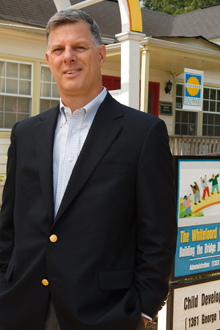
Michael Rich is an associate professor of political science and director of Emory's Office of University-Community Partnerships.
Emory professor Michael Rich and co-author Robert P. Stoker take a closer look at federal efforts to help alleviate the cycle of poverty in their new book, "Collaborative Governance for Urban Revitalization: Lessons from Empowerment Zones," published in June by Cornell University Press.
The federal government created empowerment zones in 1995 to help alleviate the cycle of poverty. Rich, associate professor of political science and director of Emory's Office of University-Community Partnerships, compared the results of empowerment zones in six cities over 10 years to examine the factors that contribute to their effectiveness.
Below, Rich discusses their findings, the role of good governance, how each city fared, and lessons for future poverty initiatives.
Your book is about the Urban Empowerment Zones in six U.S. cities — Atlanta, Baltimore, Chicago, Detroit, New York and Philadelphia — and how they fared over a decade later. What are empowerment zones?
This was a special group of cities that, for the first time, received a large investment [$100 million per city] from the federal government and access to some pretty powerful tax incentives to focus on improving their high poverty neighborhoods. It had never been done before. We wanted to see what happened over the 10 years when the empowerment zones were active.
My co-author did the Baltimore fieldwork and I did the Atlanta fieldwork, and we also examined data for the four other empowerment zone cities. The findings were very interesting and we decided to tell the story in a more compelling way than a research story. We felt that there was a story there that needed to be told.
And what did you find?
The primary finding is that good governance matters. Not just the effectiveness of the city government but also how well the cities fostered a collaborative approach to tackling the problems in their high poverty neighborhoods and effecting lasting improvement in the lives of residents.
We distilled good governance to three key ingredients:
- The breadth of participation: Did the city have representation from key sectors to be involved in solutions and how broad-based was that representation?
- Meaningful citizen participation: Did the city govern the initiative in such a way that the residents of the neighborhood could be involved throughout the planning and implementation process?
- Program integrity: Did the city implement the initiatives in a way that was transparent? Were there clear requirements to receive grants and or tax incentives or was it very opaque and full of favoritism? Was there an ability to recognize when programs weren't working and shift gears and invest the resources in things that would work?
We compared neighborhoods in the empowerment zones and compared them to similar neighborhoods not included in the empowerment zones. We looked at what happened in the empowerment zones neighborhoods over the span of the initiative to see what effects, if any, the empowerment zones had on the neighborhoods.
Were any of the empowerment zones successful and if so, which cities fared best?
Cities such as Baltimore and Philadelphia had zone neighborhoods that were more successful than their comparison neighborhoods on most of the indicators we examined.
Atlanta was at the other end of the continuum; its zone neighborhoods faired worse than comparison neighborhoods on most indicators. The other three cities were in the middle; some indicators were better, some worse.
What accounts for the wide variety of results?
All the zone neighborhoods were pretty comparable. They had similar poverty rates and similar unemployment rates. We thought it might matter what the cities did with that $100 million. Did the city emphasize job creation, education or services?
But we found that program choices did not seem to explain the differences in success. When we ranked the empowerment zone cities on their quality of governance, we found a direct relationship between governance and revitalization outcomes. So essentially, we found that what the cities did didn't matter as much as how they did it.
What can we learn about poverty initiatives from the empowerment zones?
Cities and governments should think very hard about how they design and execute these sorts of collaborative endeavors.
You have to make sure you have the right people at the table, a broad and deep governing council not just representing big business, but also small businesses, unions, nonprofits, public agencies and officials, and civic leaders.
Residents also need to have a meaningful role and be allowed to give voice to the challenges that they're facing so you're not just up at 50,000 feet with elites talking about how to help the neighborhood. Baltimore and Philadelphia figured that out; most of the other cities didn't.
Baltimore and Philadelphia also invested in building community capacity. They had agencies behind the governing council that could get the work done. They knew how to underwrite loans for small business, housing rehabilitation and workforce development. They knew how to put the pieces together to translate their plans into action.
Both cities also focused on sustainability —what happens when the empowerment zone initiative ends. For instance, Philadelphia took $10 million of their funds and created a neighborhood endowment fund, managed by United Way, to support the work of agencies working to fight poverty in their empowerment zone. That work will go on well beyond the empowerment zone initiative.
